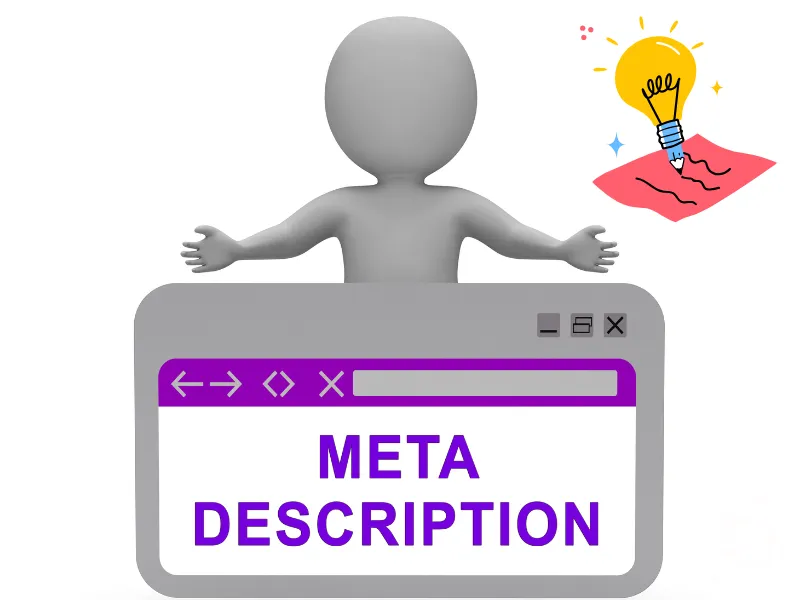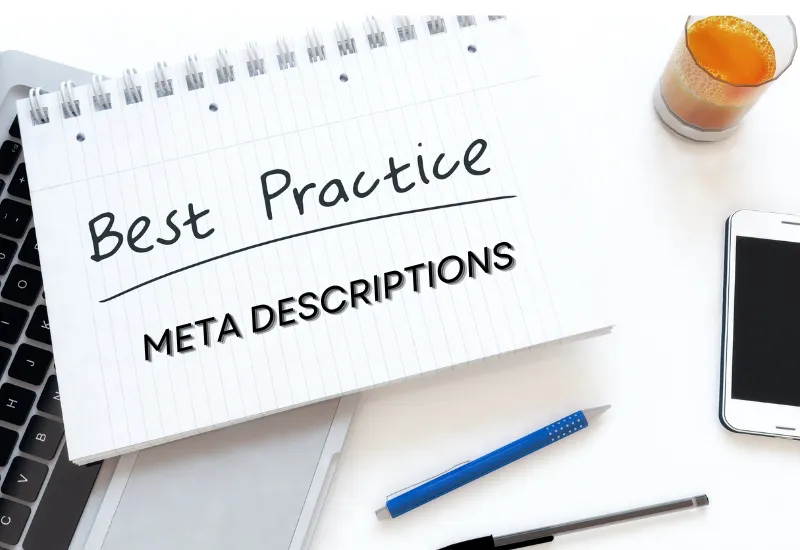Effective SEO Tips: Writing Meta Descriptions For Your Small Business Website

-
Jim Traister
Struggling to make your website stand out on Google? A strong meta description can help improve clicks and boost traffic. This article will show you how to write effective, eye-catching meta descriptions for your small business.
Keep reading—you don’t want to miss this!
Key Takeaways
- Meta descriptions should be under 155 characters. This prevents truncation in Google search results and ensures clarity.
- Use active voice, action words like “boost” or “discover,” and clear CTAs to grab attention and drive clicks.
- Include relevant keywords naturally for better SEO but avoid keyword stuffing or duplication across pages.
- Tools like Ahrefs’ Free Meta Description Generator can save time and create SEO-friendly content easily.
- Well-crafted meta descriptions improve click-through rates (CTR), increase website traffic, and support higher search rankings.
The Role of Meta Descriptions in SEO

Meta descriptions act like a store window, giving searchers a quick peek at your page. They help grab clicks from Google search by standing out in the sea of results.
Capturing user attention in search results
Short, clear meta descriptions act like store signs. They grab eyes on a crowded Google Search Results Page (SERP). Use no more than 155 characters to hook users fast. Active voice keeps the tone direct and easy to follow.
For example, “Boost your business with expert SEO tips—click to learn more!” speaks directly to search intent.
Power words like “boost,” “unlock,” or “discover” spark curiosity. Tailoring each description ensures content stays relevant and fresh for search engines like Google. Avoid duplicate meta descriptions; they confuse both users and crawls, lowering your page rank on organic search results.
Keeping descriptions within 155 characters using active voice
Capturing attention on the search engine results page means staying sharp with meta descriptions. Using active voice creates interest and clarity. Limit descriptions to 155 characters for better visibility in organic search results, as Google recommends.
Include focus keywords naturally in your description tags without keyword stuffing. Use power words like “boost,” “enhance,” or “discover” to create a call-to-action (CTA) that drives clicks.
For example: *“Boost website traffic! Discover tips specifically made for small business SEO today.”
Craft concise, clear, and clickable content—every word counts.

Avoid duplicate meta descriptions across category pages or branded keywords as it confuses search engines like Google Search Console.
Key Features of High-Impact Meta Descriptions

Strong meta descriptions grab attention like a catchy headline. They use simple, clear words to make users click on your link.
Crafting summaries that stay within 155 characters
Keep descriptions short—no more than 155 characters. This avoids truncation in search engine results pages (SERPs). Use active voice to grab attention quickly. For example, “Boost sales today—shop handcrafted candles with free shipping!” stands out and fits perfectly.
Use relevant keywords like “target audience” or “organic search results.” Reflect the page content honestly while keeping it engaging. Small tweaks here can boost click-through rates (CTR) significantly, leading to better website traffic and user engagement.
Using compelling language to boost click-through rates
Short, powerful words grab attention. Action verbs like “Discover,” “Boost,” or “Achieve” inspire curiosity. Phrases such as “Sign up today” or “Learn more now” encourage quick action.
Think of meta descriptions as mini-ads driving traffic from search engine result pages (SERP). Use emotional and persuasive language to make users click through.
People don’t buy what you do; they buy why you do it. – Simon Sinek

Focus on the benefit for the reader, not just your business. Words that build trust and urgency can work wonders—like “trusted,” “proven,” or “limited-time.” Avoid overcomplicated phrases; clear communication wins clicks every time!
Designing Unique Meta Descriptions for Small Business Sites
Make meta descriptions that match the page’s focus. Use keywords your customers search for, and keep it snappy to grab attention!
Integrating relevant keywords and utilizing an active voice
Use target keywords early in your meta description. Search engines index these quickly, boosting search visibility. Active voice keeps the text clear and engaging for readers. For example, instead of “Products are offered by us,” say “We offer products.”
Keywords like “organic search results” or “website traffic” match search intent. Avoid duplicate meta descriptions; they confuse Google Search Console and hurt SEO optimization.
Each page deserves fresh content to improve online visibility and click-through rate (CTR).
Meta description examples that drive engagement
A strong meta description grabs attention and encourages clicks. It highlights key points while using clear, action-driven language.
- “Boost your website traffic – Proven SEO tips for small businesses! Learn how to rank higher and grow your audience today.” This example places action words like “boost” upfront and includes a clear call-to-action (CTA).
- “Shop stylish women’s shoes – affordable prices, free shipping! Perfect pairs for every occasion in one click.” This focuses on specific benefits like free shipping to excite shoppers.
- “Grow your business fast with expert marketing strategies. Find tools for better visibility and higher sales now!” It uses urgency and target keywords to appeal to growth-focused business owners.
- “Discover healthy recipes that fit your busy lifestyle. Easy meals, nutritious snacks, all in one place!” This keeps it simple but speaks directly to the needs of time-strapped users.
- “Learn social media tricks to increase brand engagement instantly! Step-by-step guides created for small business owners.” Mentioning “social media” attracts those wanting digital solutions.
- “Explore Instagram-worthy decor pieces – top trends at unbeatable prices! Upgrade your home while staying on budget.” Stylish keywords attract visual shoppers looking for deals.
- “Cut energy costs with smart-tech gadgets today! Save money without sacrificing comfort or convenience.” The focus is on real savings using power words like “cut” and “smart-tech.”
- “Plan stress-free vacations – book deals you can’t miss! Tips for travel lovers who want more adventure for less.” Highlighting benefits hooks travel enthusiasts seeking easy planning options.
- “Master digital marketing with our easy guide – top tips for small business owners to grow online presence & sales.” Clear topic hints promise value within 155 characters, enhancing click-through rates (CTR).
- “Find fitness plans online – no gym required! Achieve health goals from the comfort of home today.” Addressing convenience motivates users seeking quick results without hassle.
Tools for Creating Effective Meta Descriptions
Use online tools to make writing meta descriptions easier. They help you find the right words, keep it short, and boost clicks.

Using Ahrefs' Meta Description Generator
Ahrefs’ Free Meta Description Generator can save you time. It creates descriptions that fit perfectly within the recommended 155-character limit. No coding skills? Don’t sweat it! This tool designs SEO-friendly phrases, helping boost your online visibility in organic search results.
Small business owners can plug it into their workflow for easy content optimization. Pair it with keyword research to match user intent and drive clicks from Google search results.
Tools like Yoast SEO make adding these descriptions a breeze on WordPress sites—no HTML codes or tags needed!
Importance of concise descriptions for SEO effectiveness
Short meta descriptions grab attention fast. They fit neatly in Google search results by staying under 155 characters, avoiding cuts. This helps highlight key info and ensures users see the full message.
Quick, clear text also improves your click-through rate (CTR). It creates better user engagement, driving more traffic to your website without confusion or clutter.
How Meta Descriptions Influence SEO Success
Meta descriptions help pull people to your site by making search results more appealing. They boost website traffic and can improve your click-through rate (CTR).

The impact on click-through rates and web traffic
Well-written meta descriptions can boost your website traffic. They act like a shop window, drawing users in with clear and appealing language. A compelling description increases click-through rates (CTR) by leading users to think, “This page has exactly what I need!” Accurate summaries of content reduce bounce rates, keeping visitors engaged.
Search engines reward high CTRs with better rankings. If more people click on your link from search engine results pages (SERPs), the web sees it as valuable content. For small business websites, these clicks translate into better online visibility and potentially higher sales.
Writing Best Practices for Meta Descriptions
Use action words, keep it short, and spark curiosity—these tricks can boost clicks fast.

Employing active voice and direct calls to action
Start with action verbs that encourage clicks. Write descriptions like, “Shop now for deals,” or “Sign up today to save.” Keep the tone direct and engaging. For small business owners, focus on clear user benefits like free shipping or exclusive offers.
Include calls-to-action (CTAs) in your meta descriptions. Phrases such as “Learn more,” “Get started,” or “Join us” spark interest and drive clicks. Use active voice to sound confident and lively.
Add target keywords naturally for search engine optimization (SEO).
Conclusion
Writing great meta descriptions doesn’t have to be hard. Keep them short, snappy, and full of keywords. Use clear action words to grab attention and prompt clicks. Focus on matching search intent while making each description different.
These small tweaks can drive big results for your website traffic!
Related Articles
Discover how understanding metadata can transform your business website into a powerful tool for driving traffic, improving SEO, and boosting engagement—read more to unlock its potential!
Streamline your website’s performance with our essential SEO maintenance checklist—learn how to stay ahead in search rankings and keep your traffic thriving!
Unlock the secrets to enhancing your SEO and dominating SERPs with simple strategies that drive clicks and boost your online presence—read more to take control!
Don’t Let Poor Meta Descriptions Hurt Your Website’s Traffic!
- Boost Your Online Visibility: Master the art of writing concise, action-oriented meta descriptions that align with your business goals and search intent.
- Proven SEO Strategies at Your Fingertips: Discover how to use active voice, target keywords, and powerful CTAs to stand out on search engine results pages (SERPs).
- Take Action Today for Better Results: Contact us now to learn the secrets to creating meta descriptions that maximize clicks and grow your website traffic!

About Jim Traister
Learn more
Frequently Asked Questions
What is a meta description, and why does it matter for SEO?
A meta description is a short summary of your webpage that appears in search engine results pages (SERPs). It helps improve click-through rate (CTR) by showing users content relevance before they visit your site.
How can I write effective meta descriptions for better website traffic?
Focus on target keywords, use power words, and include a clear call-to-action (CTA). Make sure the text aligns with search intent to increase user engagement and drive organic search results.
Should I avoid duplicate meta descriptions across my webpages?
Absolutely! Duplicate meta descriptions confuse both Google Search algorithms and users. Write unique content tailored to each page to boost online visibility and CTR.
Can keyword research help optimize my meta descriptions?
Yes, keyword research identifies high-search-volume terms like branded or long-tail keywords that you can include in your HTML tag or structured data for better SEO performance.
Are there tools available to check how well my meta descriptions perform?
SEO tools like Google Search Console can analyze bounce rates, track CTRs from Google Search results, and ensure your landing page optimization efforts are on point.
What role do CTAs play in writing strong meta tags?
Calls-to-action encourage clicking through from SERPs by guiding readers toward specific actions—like “Learn More,” “Shop Now,” or “Get Started.” They’re essential for boosting user engagement while improving SEM outcomes!


